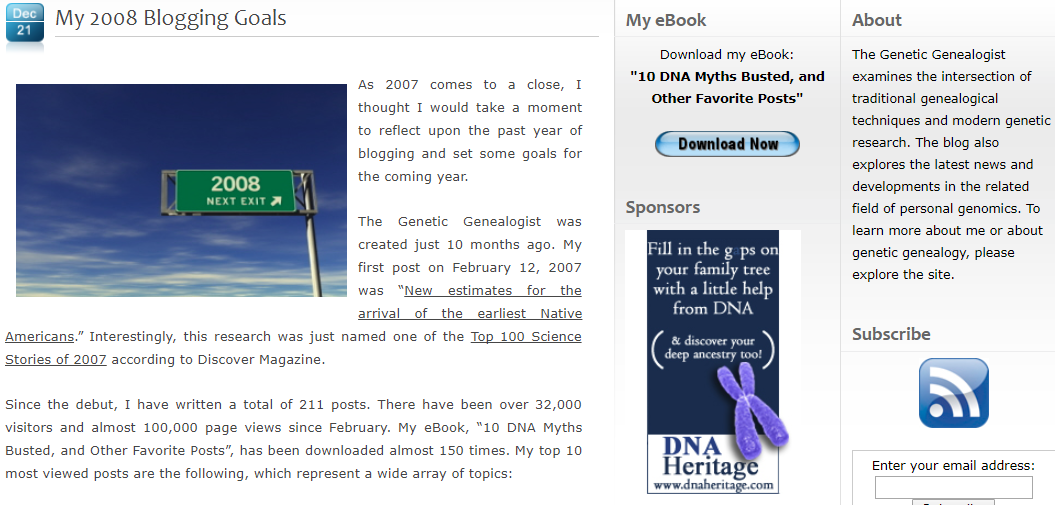Search Results for:
Informed Consent Agreement and Beneficiary Agreement
Last year in the Facebook group Genetic Genealogy Tips & Techniques, we were discussing the need in the community for an informed consent agreement and a beneficiary designation form. Provided below are informed consent agreement and beneficiary designation form that I drafted with very helpful feedback from the GGT&T community early last summer. Feel free to use these agreements/forms pursuant to the disclaimers below, and pursuant to the CC license under which they are distributed!
Please note that this is NOT legal advice. I do NOT make any representation that these forms are legally binding or sufficient for their intended purpose. I highly recommend that you see an attorney if you have any questions or concerns.
Informed Consent Agreement
DNA Central! A New DNA Resource Launching April 2018!

DNA is hard. There’s no way around it. Sure, it’s easy to spit in a tube, but once you have all those percentages and centiMorgans and matches, how do you make sense of it? What does it all mean? And how can it help you understand where you came from and how to use it to explore your ancestry?
Announcing DNA Central, a new resource for everything DNA! This new subscription-based site will have blog posts about the latest and greatest, how-to content (including a “What Next?” series), short videos (such as the “3-Minute DNA” series), webinars, and forums! We’ll also have monthly giveaways and much more! It’s everything you need to finally understand and apply the results of your DNA testing!
TGG’s Top Posts in 2017
I started The Genetic Genealogist on February 12, 2007 with my first post, “New estimates for the arrival of the earliest Native Americans.” There were few educational resources for genetic genealogy back then, and all testing was Y-DNA and mtDNA. Although 23andMe would launch the first large-scale atDNA test a few months later in November of 2007 (see “23andMe Launches Their Personal Genome Service” announcing the $1,000 test), it would be a couple of years until they used the results for cousin matching. Today, almost 11 years later, there are 617 posts with more than 310,000 words.
Here’s a screenshot from the blog in December 2007:
This year I posted about 30 times about a wide variety of topics. Here are the most popular posts in 2017:
Ohio Genealogy Seminar 2018
DNA/Genetic Genealogy Seminar
A Small Segment Round-Up
If you aren’t already a member of the coolest Facebook group ever, Genetic Genealogy Tips & Techniques, you really should be! We have a friendly and engaging environment, and everyone learns something new every day!
This post is meant to answer a question or issue that is raised almost daily in the group, and that is the issue of small shared DNA segments. Although these small segments are alluring, they are the mythological sirens of the genealogical world!
Small Segments Executive Summary
Here’s a bite-sized summary of the content below:
- Many to most small segments (at least 7 cM and smaller) are FALSE, meaning they are NOT actually shared by the two matches, and therefore do NOT indicate shared ancestry;
- This is supported by a 2014 paper by 23andMe scientists showing that at least 33% of 5 cM phased DNA segments are false-positive (and it’s much worse for unphased segments or segments smaller than 5 cM);
- This is further supported by evidence that anywhere from 20-35% of distant matches at a testing company are not shared with either tested parent;
- This is further supported by evidence that phasing your DNA with two tested parents significantly reduces the number of matches below 10 cM (with proportionally more matches reduced as the segment size gets smaller);
- There is currently no evidence that triangulating segments or finding a paper trail provides a mechanism for distinguishing between false segments and valid segments;
- Since we can’t tell the difference between false small segments and valid small segments, we must avoid these small segments to avoid poisoning our genealogical conclusions with false data; and
- Beware any research or conclusion that uses these small segments without specifically addressing the issues that are known – based on all the scientific research and evidence gathered to date – to surround small segments.
If you’re interested in learning more, keep reading!
Small Segments In Detail
One of the most common questions in the group has to do with small segments. There’s no exact definition of “small” when it comes to small segments, but many of us define them as being a single segment of DNA of 7 cM or smaller. Others use 5 cM or smaller, while others use 10 cM or smaller. Personally, I consider segments of 7 cM or less to be “small,” although when I’m being very conservative I use a definition of 10 cM or smaller.
All-Day Seminar at the Tennessee Genealogical Society
Stay tuned for more details!
New Hampshire Society of Genealogists
Stay tuned for much more information!
The Kelowna & District Genealogical Society “Harvest Your Family Tree” Conference 2018
Exciting Speakers, Genealogical Marketplace, One-on-One Consultations, Friday Reception, Lots of Great Door prizes, Raffles, Lots of Fun & Lots of Information. Stay tuned for more information coming in early 2018!
Genealogical Research Institute of Virginia Fall 2018 Conference
Genealogical Research Institute of Virginia Fall 2018 Conference
